Physical education and sports sector progress in Rostov region
ˑ:
PhD, Associate Professor T.A. Stepanova1
R.M. Olkhovsky1
PhD E.A. Vashchenko1
PhD N.V. Ryzhkin2
1Rostov Regional Department of the All-Russian Public Organization "Russian Students Sport Union", Rostov-on-Don
2Southern Federal University, Rostov-on-Don
3Don State Technical University, Rostov-on-Don
Keywords: physical education, sports, students, education, youth.
Background. Decision-makers at every level of the Russian government system give a growing priority to the policies to effectively lure university youth into academic sports and offer new progress opportunities for gifted young athletes, albeit the relevant studies have still reported little if any progress in the academic physical activity promotion initiatives. President Vladimir Putin at his meetings with the Physical Education and Sport Council of the Presidential Administration has repeatedly emphasized the growing national demand for healthy lifestyle and sports. Further focused efforts need to be taken to support the initiatives to engage young people into habitual physical trainings and sports; improve the system of academic competitions; encourage student sport movements; and advance the GTO Complex implementation project. Of particular interest in this context are the findings of the federal GTO Complex implementation progress report of 2016. It reports leadership of the Volga Federal District in qualifications for the GTO Complex tests with the qualifiers to the total population ratio reported at 3.7%. The Southern Federal District reports the qualifiers to the total population ratio at 1.8%, albeit the actual test success rate is still as low as 1%.
Objective of the study was to analyze the physical education and sports sector progress data reported by the Rostov region for the last 5 years (2014-2017).
Study findings and discussion. The reporting data show a minor progress in the number of students served by the academic physical education and sport system on a regular basis, albeit the number of sport competitions and events are reported to fall for the period – that may be due to the still inadequate supply of the academic sport facilities versus the demand; with many available academic sport assets being in need of restoration and upgrade, according to the federal GTO Complex implementation progress report of 2016.
Table 1. Full-time student populations reported by the regional universities as of October 1, 2017
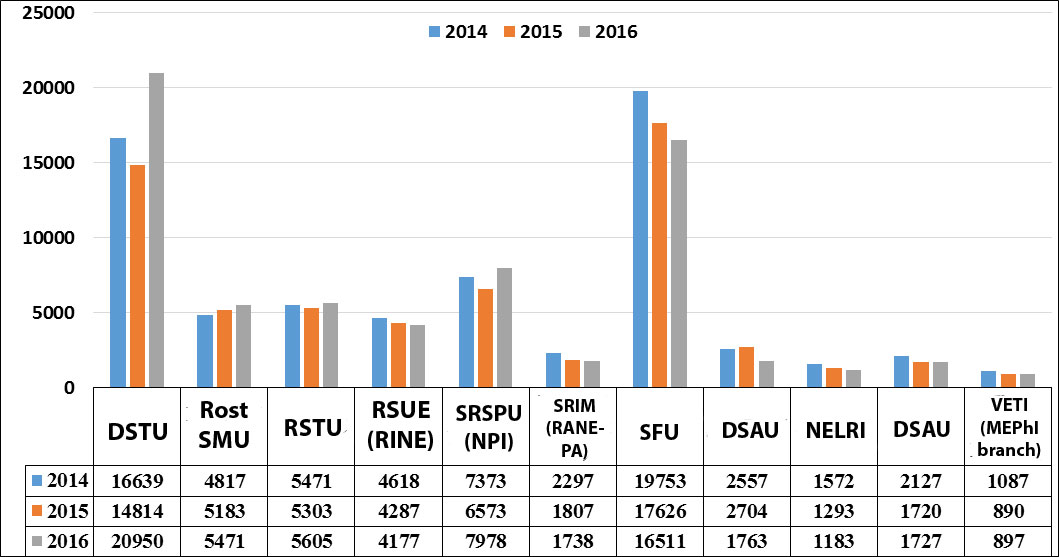
It should be mentioned that the full-time student population for the last 3 years was on the fall (see Table 1) with the growing share of the students attributed to special health groups: see Table 2.
Table 2. Full-time university student populations attributed to special health groups, as of October 1, 2017
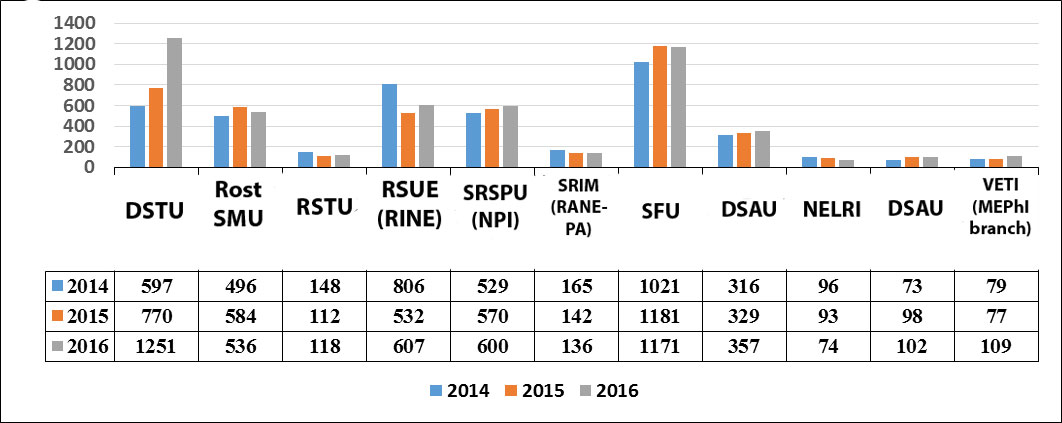
Of special concern in this context is the fact that the full-time academic physical education and sport service personnel has been reduced for the period: see Table 3.
Table 3. Full-time academic physical education and sport service personnel, as of October 1, 2017
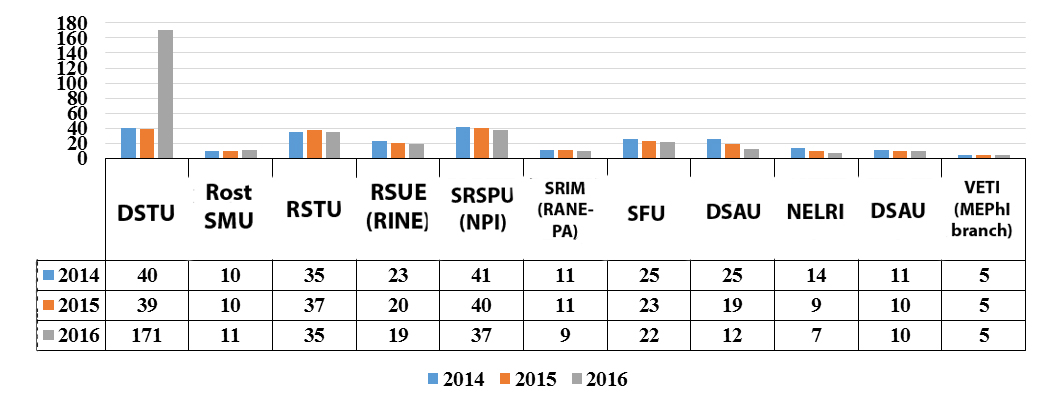
It should be also mentioned that the universities reporting contraction of the student populations for the period have reduced the academic physical education service personnel in a disproportional manner: see Table 4.
Table 4. Full-time academic physical education service personnel, as of October 1, 2017
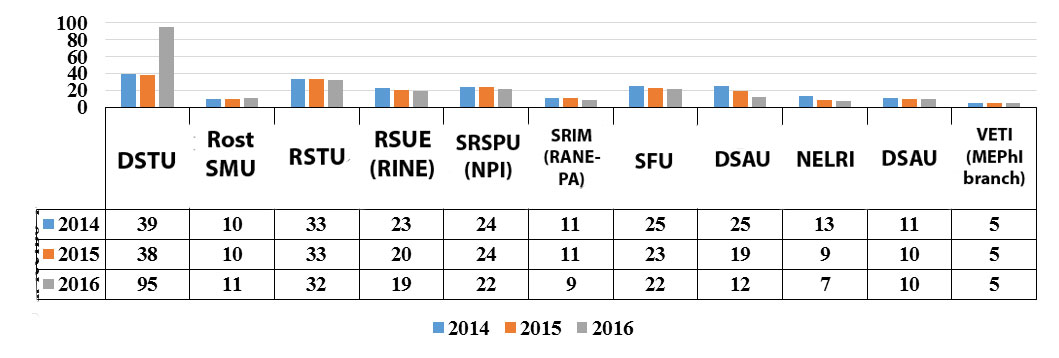
As indicated by the federal GTO Complex implementation progress report, the student sport group number has somewhat grown up for the period – largely due to the enthusiastic service of the full-time academic sport club personnel: see Table 5.
Table 5. Full-time academic sport club personnel, as of October 1, 2017
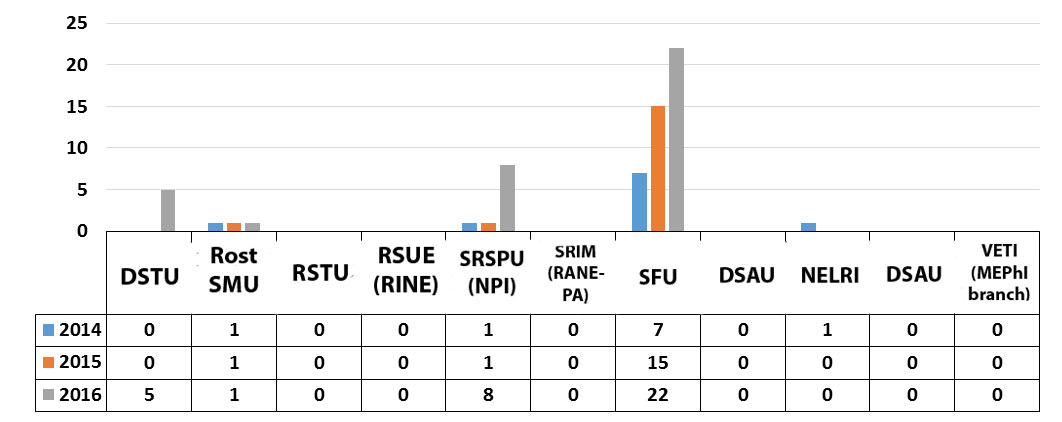
The report shows a modest growth of the full-time academic sport club personnel for the last three years, albeit a few universities in the Rostov Oblast have still failed to establish their academic sport clubs as required by the Ministry of Education and Science Order #1065 of September 13, 2013 “On Approval of Procedures for the School and Academic Sport Clubbing Activity”. The sporting student population attending the academic sport groups is reported to grow year-to-year and, hence, the competitiveness and popularity of the intra-university sport games have been on the rise as well. We have found, however, that the regional academic competitions have been on decline for the period, with 41, 40 and 41 competitive events reported for 2013, 2014 and 2015, respectively, followed by only 24 events in 2016. This trend may be considered natural in the context of the national fall in competitions for the same period, with 32, 42 and 52 competitive disciplines reported for 2013, 2014 and 2015, respectively, followed by only 37 disciplines in 2016. It is common knowledge that every academic athlete strives to compete and win and, hence, may be seriously de-motivated and discouraged by the shortage of competitive events. The numbers of the formal online registrations for the GTO Complex tests in the Rostov Oblast are reported to constantly grow for the period albeit the ratio of successful tests has been still very low in fact.
Conclusion. Despite the notable progress of the academic physical education and sport services in the regional academic educational system, there are still quite a few problems that may be solved via relevant networking sport projects conditional on an inter-regional cooperation of the research and educational systems. Federal and leading regional universities, inter-university service centers and joint networking projects have been established in every region of the Southern Federal District. In terms of the educational service, research and development process concentration policies, it is the universities that should take the lead in many innovative projects including the networking ones.
Such projects may address the professional advancement and retraining system for the academic personnel; special recruitment system for the regional physical education and sports sector; academic support for the elite training systems in different sports; academic sport research projects, including interdisciplinary research; innovative think tanks established at the universities etc.; improvements in the academic physical education and sports service system driven by new service models and technologies; GTO Complex promotion initiatives with a wide range of mass sport events including the corporate ones.
References
- Andryushchenko L.B., Loseva I.V. Tekhnologiya formirovaniya gotovnosti k razvitiyu fizicheskoy kultury u studentov kak faktor sokhrannosti zdorovya [Technology of building student's competency for development of physical education as part of health protection program]. Ministry of Agriculture RF, RSAU - Timiryazev MAA publ., Moscow, 2009.
- Andryushchenko L.B., Filimonova S.I. Fizicheskaya kultura i studencheskiy sport v novykh sotsialno-ekonomicheskikh usloviyakh Rossii: sovremenny vzglyad i tochki rosta [Physical education and academic sports in new socio-economic national situation: modern vision and growth points]. Teoriya i praktika fiz. kultury, 2018, no. 2, pp. 73-76.
- Andryushchenko L.B., Filimonova S.I. Studencheskie sportivnye ligi –- perspektivnye napravleniya razvitiya massovogo sporta [Student sport leagues - promising areas for development of mass sports]. Mater. mezhdunar. nauch.-prakt. konf. ‘Vserossiyskiy fizkulturno-sportivny kompleks ‘Gotov k trudu i oborone (GTO)’ i massovy sport v sisteme zdorovogo obraza zhizni naseleniya’ [Proc. Intern. res.-pract. conf. 'Russian physical culture and sports complex ‘Ready for labour and defence (GTO)’ and mass sports in healthy lifestyle system of the population'], 2016, pp. 219-225.
- Kazantinova G.M., Andryushchenko L.B., Charova T.A. Zdorovy obraz zhizni v professionalnoy deyatelnosti spetsialista. Ucheb. posobie dlya studentov selskokhozyaystvennykh vysshikh uchebnykh zavedeniy, obuchayushchikhsya po distsipline ‘Fizicheskaya kultura’ [Healthy way of life in specialist's professional work. Study guide for agricultural university students majoring in Physical Education]. Volgograd, 2009.
- Kolomok O.I., Andryushchenko L.B., Shekhanin V.I. Kompleks usloviy formirovaniya fizicheskoy kultury studentov [Complex of conditions for building students' physical culture]. Vestnik Samarskogo gosudarstvennogo ekonomicheskogo universiteta, 2006, no. 2, pp. 379-385.
- Kondrakov G.B., Andryushchenko L.B., Bezveselnaya Z.V. et al Kontseptsiya formirovaniya rekreatsionnoy fizicheskoy kultury v ekonomicheskom vuze [Recreational physical culture formation concept for economic university]. Teoriya i praktika fiz. kultury, 2016, no. 9, pp. 22-24.
- Filimonova S.I., Andryushchenko L.B., Filimonova Y.B. Prostranstvo fizicheskoy kultury i sporta vuza [Academic physical education and sports environment]. Kultura fizicheskaya i zdorovye, 2017, no. 4 (64), pp. 13-16.
Corresponding author: tastepanova@sfedu.ru
Abstract
The study analyzes the physical education and sports sector progress data reported by the Rostov region for the last 5 years. The reporting data shows that, despite the notable progress of the academic physical education and sport services in the regional academic educational system, there are still quite a few problems that may be solved via relevant networking sport projects conditional on an inter-regional cooperation of the research and educational systems. Federal and leading regional universities, inter-university service centers and joint networking projects have been established in every region of the Southern Federal District. In terms of the educational service, research and development process concentration policies, it is the universities that should take the lead in many innovative projects including the networking ones. Such projects may include the professional advancement and retraining system for the academic personnel; special recruitment system for the regional physical education and sports sector; academic support for the elite training systems in different sports; academic sport research projects, including interdisciplinary research; innovative think tanks established at the universities etc.



